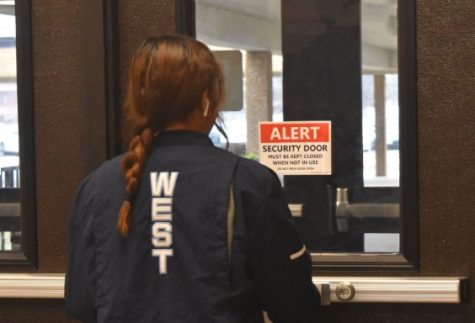Schools are not prisons
January 11, 2023
Often holding someone accountable has made our society safer, but in the case of school shootings, this has proven to be a complex task. With other crimes, accountability entails placing restrictions and punishments on perpetrators; with school shootings, the opposite has taken place.

In the past decade, politicians have urged reinforcing school security by “hardening” schools. Proposed methods include adding bulletproof doors and windows, metal detectors, door-locking systems and — in some cases — armed guards. At Parkway West, this entails prohibiting students from propping open doors or letting outsiders in during the school day, as well as having an onsite police officer.
“Obviously the issue of school shootings needs to be addressed on a bigger scope and with more urgency. But, for now, protecting [ourselves] is as simple as making sure doors are locked and students don’t leave the building,” Doherty said.
While basic safety measures seem reasonable, when it comes to more extreme measures like installing metal detectors or issuing bullet-proof backpacks, they seem restrictive and overbearing. A simple question arises: Why are students’ freedoms sacrificed when we can place restrictions on guns and ammunition?
Not to mention, these safety measures simply won’t suffice in the long run. CVPA had multiple safeguards, including metal detectors, at least one onsite security officer guarding doors and security cameras. Yet, on the fateful day of the shooting, the 19-year-old former CVPA student shooter was able to both enter the building and carry an AR-15-style rifle with 600 rounds of ammunition.
“I [was a student teacher] in the same building as CVPA, and there are many systems in place that protect students from intruders. Our bags were searched, and overall, the environment was very safeguarded; there are virtually no discipline issues. It’d be the last place I would ever think anything like this would happen,” Doherty said.
Despite all these safety measures in place, they failed: two people are dead, and seven were in the hospital injured. CVPA was not the only school whose safety measures failed to protect them: Door-locking systems failed Robb Elementary in Texas and monitored entrances failed Parkland High School in Florida.
“There is already a feeling of paranoia living in America as a student, especially now in St. Louis. We’ve had more than three incidents [in our area], and we are anxious about what is to come. School should feel like home, but now that is being taken away from us,” Kerber said.
School security has become a $2.7 billion business in America, and no research or hard evidence guarantees these measures are effective. In fact, hardening schools comes with its own set of negative consequences, specifically on school climate and student mental health.
Hardening techniques can make schools seem prison-like, leading to students with more mental problems and, consecutively, a higher chance of unintended violence. In addition, it hurts the development of young adults; schools with high-tech security often show correlated increased levels of fear and anxiety among students and staff. On top of that, some hardening techniques, like arming teachers, can lead to disruption in learning and an overall parlous educational environment. Cognitive biases can put certain students of color, gender or disability at a higher risk of being shot by an adult than their peers, in the facade of a safe environment.
Hardening schools is not a solution, and it is time schools employ a different technique to combat school shootings.
